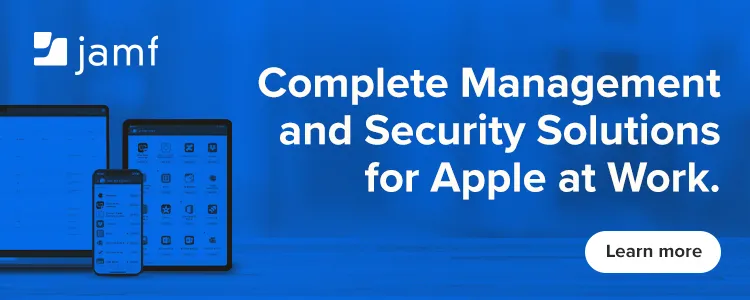
Apple @ Work is brought to you by Jamf, the only company in the world that provides complete management and security solutions that are enterprise secure, consumer simple, and protect personal privacy. Today, more than 62,000 organizations trust Jamf to manage and secure more than 27 million devices worldwide. Learn more.
WWDC has come and gone once again, and it’s going to be a fun summer monitoring the betas to see how everything with the latest versions of iOS, macOS, and tvOS progress. As I was pondering the newest ways to improve Apple device management, I concluded that Apple’s MDM APIs for vendors to build on top of is a key part of why Apple devices in the enterprise continue to provide a great user experience.
About Apple @ Work: Bradley Chambers managed an enterprise IT network from 2009 to 2021. Through his experience deploying and managing firewalls, switches, a mobile device management system, enterprise-grade Wi-Fi, 100s of Macs, and 100s of iPads, Bradley will highlight ways in which Apple IT managers deploy Apple devices, build networks to support them, train users, stories from the trenches of IT management, and ways Apple could improve its products for IT departments.
If you talk to anyone who loves the Mac experience personally about what they think of having their Mac managed by their workplace, they’ll cringe. Device management historically has meant complications, slowdowns, and incompatibilities. These people aren’t wrong to feel this way either. If you worked in the workforce during the days when everyone used a Windows PC heavily tied to Active Directory and Microsoft Server, you know that the overhead of these platforms could slow down your computer compared to the one you used at home. As company’s deployed different technology to handle different aspect of IT’s security needs, bloatware after bloatware was added. Users sacrificed the best experience for IT to meet its security needs.
Enter Apple Device Management
Apple’s MDM APIs are built on a simple mindset: Preserve the great Apple experience while enabling IT to properly manage their fleet effectively. It’s simple to envision, but it’s complicated in practice to invent. That’s what Apple has done, though.
Apple’s base layer for device management is the key part of achieving this reality, though. The company built the building blocks inside of macOS, iOS, and tvOS for other companies to build management systems. The APIs built into all of its software platforms ensure that every company is using the same technology for the basics of device management. Where MDM vendors get to innovate is on layer 2. The strong base layer of APIs ensures that users will always have a great Apple experience at work. No company can build a management product that can impact how the product works outside of what Apple envisioned and planned for. Even Apple follows this model with Apple Business Essentials. I’ve even made a comment to others that Apple’s APIs are likely to get better with Apple Business Essentials because Apple’s internal teams will be forced to use the same APIs as other MDM vendors.
So what can companies build on layer 2? They can build anything they want as long as it doesn’t break the base layer. Companies can implement new ways to install and update apps, create new automations, new ways to your fleet to gain insights, and more.
Summary on Apple’s MDM APIs
By building a strong base layer of API controls, Apple has ensured that third-party companies can’t build management technology that interferes with a great Apple experience for end users. On the other hand, Apple continues investing in technology to add lightweight control, management, and insights to IT departments.

Apple @ Work is brought to you by Jamf, the only company in the world that provides complete management and security solutions that are enterprise secure, consumer simple, and protect personal privacy. Today, more than 62,000 organizations trust Jamf to manage and secure more than 27 million devices worldwide. Learn more.
FTC: We use income earning auto affiliate links. More.







Comments